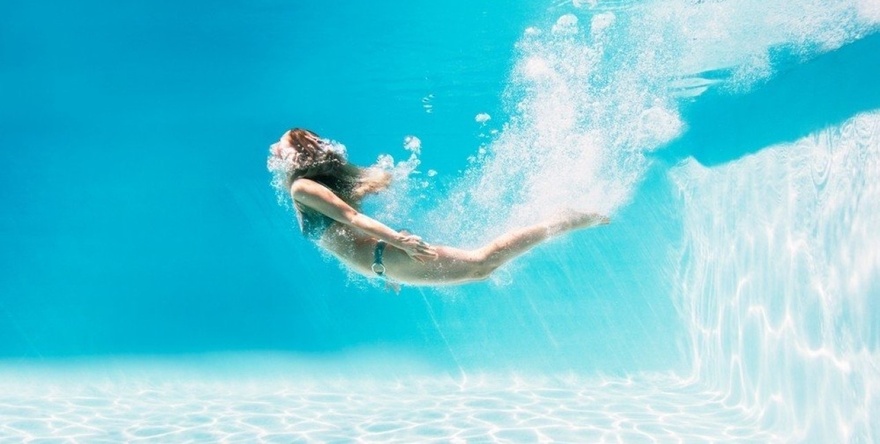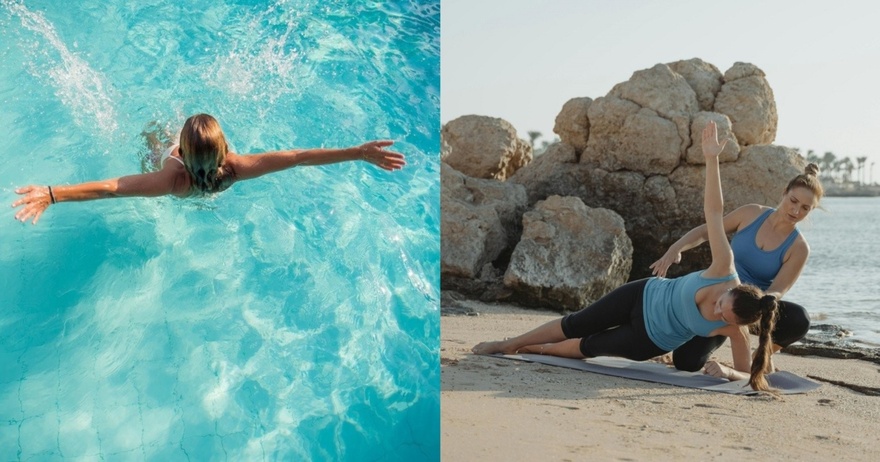Give your summer body a fantastic boost in the most fun way! If you’re looking for a break from your usual fitness routine, taking up aquatic exercise offers a refreshing and effective alternative. Exercising in the sea provides a full-body workout while cooling off in the water, making it an enjoyable way to burn calories and stay fit.

Why Choose Aquatic Exercise?
- Enhanced Resistance and Efficiency
Water is approximately 800 times denser than air, which means it provides natural resistance to your movements. This resistance helps to engage and strengthen muscles more effectively than traditional land-based exercises. Aquatic workouts often lead to increased calorie burn in a shorter period, making them highly efficient for those with limited time.
- Reduced Impact on Joints
One of the greatest benefits of exercising in the sea is the reduced impact on your joints. The buoyancy of water supports your body. This makes it an excellent choice for individuals with joint issues, arthritis, or recovering from injuries.
- Support for Various Health Conditions
Water-based exercises are particularly beneficial for pregnant women, older adults, and those with conditions such as osteoporosis, fibromyalgia, and balance problems. The water’s natural resistance helps in building strength and endurance without exacerbating physical discomfort.
- Natural Coolness
Exercising in the sea provides a cooling effect that helps regulate your body temperature. This can make your workout more comfortable, especially during the hot summer months. The cool water helps prevent overheating and keeps you refreshed throughout your session.

5 Effective Sea Exercises for a Full-Body Workout
Here are five dynamic exercises you can try in the sea to engage your entire body, enhance your fitness level, and make your summer workouts enjoyable.
- Water Walking
Water walking is an excellent starting exercise to get accustomed to the resistance of the sea. It’s a low-impact activity that targets your arms, torso, and lower body. As you progress, you can increase the intensity by using hand or ankle weights.
How to:
- Start by walking in shallow water, around waist height.
- Lengthen your spine and walk by pressing first on your heel and then on your toes, rather than walking solely on your toes.
- Keep your hands at your sides in the water and move them naturally as you walk.
- Engage your core and maintain an upright posture throughout.
- Continue walking for 5-10 minutes, gradually increasing the duration as you build stamina.
- Water Bicep Curls
This exercise is designed to strengthen your arm muscles and can be intensified with the use of water dumbbells or resistance equipment. It helps to build biceps and forearms while improving overall upper body strength.
How to:
- Step into the water until it reaches your shoulders.
- Hold water dumbbells at your sides with your palms facing up.
- Keep your elbows close to your torso as you raise your forearms to water level.
- Rotate your wrists to turn your palms downward.
- Lower your arms back to the starting position.
- Perform 1-3 sets of 10-15 repetitions for each set, resting for a minute between sets.
- Lateral Arm Lifts
Lateral arm lifts are great for targeting your shoulders and upper back. Using water dumbbells adds resistance and helps to build muscle strength in your upper body.
How to:
- Step into the water until it reaches your shoulders.
- Hold the dumbbells at your sides with your arms fully extended.
- Lift your arms out to the side until they are parallel to the water’s surface and shoulder height.
- Lower your arms back to your sides.
- Complete 1-3 sets of 8-14 repetitions, taking a short break between sets.
- Floating Bicycle Kicks
This dynamic exercise engages your core, back, and legs, simulating the action of cycling while floating in the water. It improves cardiovascular endurance and strengthens lower body muscles.
How to:
- Bend your knees up toward your chest while floating on your back.
- Push your legs outward to float flat on your back.
- Pull your knees back to your chest and then push your legs outward again to float on your stomach.
- Complete one full cycle as described. Perform 1-3 sets of 8-12 repetitions, adjusting the duration based on your fitness level.
- High-Knee Lift Extensions
This exercise focuses on strengthening your core and lower body muscles. Adding ankle weights can increase the challenge and effectiveness of the workout.
How to:
- Stand in water at waist height.
- Engage your core as you lift your right leg, bending your knee until your foot is level with the water’s surface.
- Pause with your leg raised for a few seconds.
- Extend your leg straight out and hold this position for a few seconds.
- Slowly lower your leg back down, keeping it straight.
- Repeat the movement with your left leg.
- Continue alternating legs for 5-10 minutes, adjusting the duration based on your fitness goals.

Tips for a Successful Beach Workout
- Stay Hydrated: Even though you’re in the water, you may sweat more than you realize. Drink plenty of fluids before and after your workout to stay hydrated and support optimal performance.
- Safety First: Use a life jacket if you’re not a strong swimmer or if you’re engaging in exercises that may involve deep water. Always be aware of your surroundings and ensure that the area where you’re exercising is safe.
- Listen to Your Body: Pay attention to how your body feels during and after exercise. If you experience dizziness, shortness of breath, nausea, fainting, or weakness, stop exercising immediately and seek assistance if necessary.
- Warm Up and Cool Down: As with any workout, warming up and cooling down are important. Perform gentle stretching and warm-up exercises before starting your sea workout to prepare your muscles and joints. After your workout, cool down with light stretching to help your body recover and reduce muscle soreness.
- Mix It Up: To keep your workouts interesting and effective, incorporate a variety of exercises into your routine. Mixing up different movements and activities will help you target different muscle groups and prevent boredom.
- Monitor Weather Conditions: Be mindful of the weather and sea conditions before heading out. Avoid exercising in rough water or inclement weather to ensure your safety.
- Seek Professional Guidance: If you’re new to aquatic exercise or have specific fitness goals, consider consulting a fitness professional or aquatic trainer. They can provide personalized recommendations and ensure that you’re performing exercises correctly and safely.
Conclusion
Exercising in the sea offers a unique and enjoyable way to stay fit during the summer months. With its natural resistance, low-impact benefits, and cooling effect, water workouts can provide a comprehensive full-body exercise while allowing you to enjoy the refreshing qualities of the ocean. By incorporating these five exercises into your routine, you can enhance your fitness level, strengthen your muscles, and make the most of your summer workouts. So, grab your swim gear, head to the sea, and dive into a new and exciting way to achieve your fitness goals!
She Received Meghan Markle’s As Ever Box — and Sent Something Back: ‘One Lifestyle Homemaker to Another’
Gilbert Arenas’ Son Alijah Out of Coma but Remains Intubated After Cybertruck Car Crash
Hailey Bieber Sends On-Stage Message to Justin Bieber Amid Ongoing Health Speculation and Paparazzi Battle
My husband abandoned me and our child in his crumbling, outdated shack. Little did he know, beneath that dilapidated house lay a secret room filled with gold — a treasure that had been hidden for years.






























